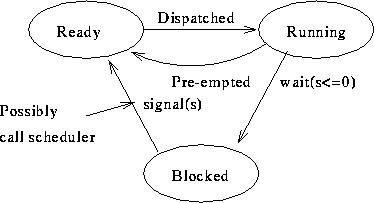The Critical Section Problem; Solutions
Tom Kelliher, CS42
Sept. 30, 1996
Critical section code:
int turn = 0; /* shared control variable */
Pi: /* i is 0 or 1 */
while (turn != i)
; /* busy wait */
CSi;
turn = 1 - i;
- Guarantees mutual exclusion.
- Does not guarantee progress --- enforces strict alternation of
processes entering CS's.
- Bounded waiting violated --- suppose one process terminates while
its its turn?
Remove strict alternation requirement
int flag[2] = { FALSE, FALSE } /* flag[i] indicates that Pi is in its */
/* critical section */
while (flag[1 - i])
;
flag[i] = TRUE;
CSi;
flag[i] = FALSE;
- Mutual exclusion violated
- Progress ok.
- Bounded wait ok.
Restore mutual exclusion
int flag[2] = { FALSE, FALSE } /* flag[i] indicates that Pi wants to */
/* enter its critical section */
flag[i] = TRUE;
while (flag[1 - i])
;
CSi;
flag[i] = FALSE;
- Guarantees mutual exclusion
- Violates progress --- both processes could set flag and then
deadlock on the while.
- Bounded waiting violated
Attempt to remove the deadlock
int flag[2] = { FALSE, FALSE } /* flag[i] indicates that Pi wants to */
/* enter its critical section */
flag[i] = TRUE;
while (flag[1 - i]) {
flag[i] = FALSE;
delay; /* sleep for some time */
flag[i] = TRUE;
}
CSi;
flag[i] = FALSE;
- Mutual exclusion guaranteed
- Progress violated (processes can ``dance'')
- Bounded waiting violated
int flag[2] = { FALSE, FALSE } /* flag[i] indicates that Pi wants to */
/* enter its critical section */
int turn = 0; /* turn indicates which process has */
/* priority in entering its critical */
/* section
flag[i] = TRUE;
turn = 1 - i;
while (flag[1 - i] && turn == 1 - i)
;
CSi;
flag[i] = FALSE;
- Satisfies all solution requirements
Lamport's Bakery algorithm
int choosing[NPROCS] = { FALSE } /* cheating initializer */
int number[NPROCS] = { 0 }
choosing[i] = TRUE;
number[i] = max(number) + 1;
choosing[i] = FALSE;
for (j = 0; j < NPROCS; j++) {
while (choosing[j])
;
while (number[j] != 0 && (number[j] < number[i] ||
number[j] == number[i] && j < i) )
;
}
CSi;
number[i] = 0;
- Created by Dijkstra (Dutch)
- A semaphore is an integer flag, indicating that it is safe to
proceed.
- Two operations:
- Wait (p) --- proberen, test:
wait(s) {
while (s == 0)
;
s--;
}
Test and (possible) decrement executed atomically.
- Signal (v) --- verhogen, increment:
signal(s) {
s++;
}
- These are operations provided by the kernel. Wait and signal are
atomic operations.
- Critical section solution:
semaphore mutex = 1;
mutexbegin: wait(mutex);
mutexend: signal(mutex);
- By defn. of semaphore, mutual exclusion is achieved.
- Also by defn. of semaphore, progress is achieved.
- Bounded waiting depends on how the wait queue is implemented (if
at all).
- Interrupt signalling:
semaphore sig = 0;
int_hndl:
signal(sig);
driver:
startread();
wait(sig);
- Resource management (pool of buffers)
Producer/Consumer problem:
semaphore count = N;
semaphore mutex = 1;
getbuf:
wait(count); /* order important here */
wait(mutex);
<find empty buffer>
signal(mutex);
return(buffer);
relbuf:
wait(mutex);
<link released buffer>
signal(mutex);
signal(count);
- Above semaphores inefficient --- spinlocks. Let waits which cause
busy waits actually block the process:

Associate a ``blocked'' queue with each semaphore.
typedef struct semaphore {
int value;
pcb *head;
}
Semaphore creation:
semaphore *createsem(int value) {
semaphore *sem;
sem = get_next_sem();
sem->value = value;
sem->head = NULL;
return (sem);
}
void wait(semaphore *sem) { /* need mutex goo here */
if (--sem->value < 0) {
<update status of current process>
insqu(sem->head->prev, current);
scheduler();
}
}
void signal(semaphore *sem) { /* mutex */
pcb *proc;
if (++sem->value <= 0) {
proc = remqu(sem->head->next);
<update status of proc>
ordinsqu(ready, proc);
if (proc->prio > current->prio)
scheduler();
}
}
Write a semaphore solution to the producer/consumer problem when you have
N buffers.
Thomas P. Kelliher
Fri Sep 27 13:57:24 EDT 1996
Tom Kelliher
